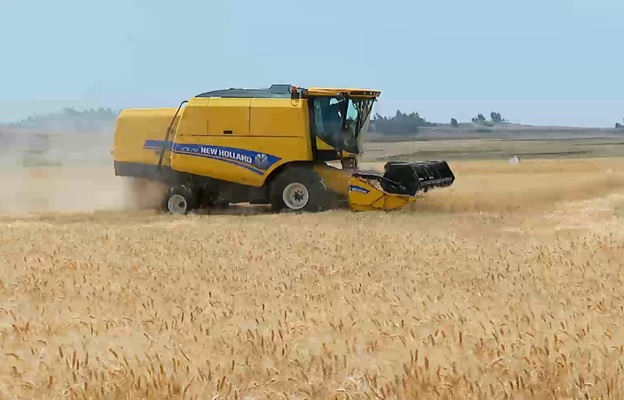
Ethiopia, a nation historically synonymous with both agricultural richness and climatic adversity, is charting a transformative course toward food security and self-sufficiency. From enduring cycles of drought to now laying the groundwork for a sustainable agricultural renaissance, the country’s journey is one of resilience, strategic reform, and visionary leadership. As the nation moves towards ensuring sustainable peace, it has also mobilized its resources to ensure food security, and positive results are being registered all over the nation.
For decades, Ethiopia’s agriculture employing over 80 percent of the population, was vulnerable to erratic weather, underdeveloped infrastructure, and limited access to modern technology. The recurrent challenges of climate change, land degradation, and dependency on food aid created a complex web that hindered progress.
Ethiopia’s vast arable land, diverse agro-ecological zones, and hardworking farming communities have always held immense potential. Recognizing this, successive governments placed agricultural development at the heart of national policy, viewing food security not only as a humanitarian imperative but also as a cornerstone for national sovereignty and socio-economic independence.
Recently, Prime Minister Abiy Ahmed (PhD) declared that Ethiopia has overtaken the status of the largest wheat-producing country in Africa, tripling Egypt’s output.
In an interview with local media, the Prime Minister stated that Ethiopia is producing wheat on an extremely large scale that underscores the government’s focus on enhancing food security and self-sufficiency.
Currently, Ethiopia has made wheat production a central pillar in its journey toward food self-sufficiency.
Through the expansion of irrigated farming, the use of improved seed varieties, and the adoption of modern farming techniques, the country has significantly increased its wheat yield and marketable surplus, it was learned.
Prime Minister Abiy confirmed that evidence on the success stories of Ethiopian wheat cultivation is pretty much clear.
“Anyone traveling just a few kilometers outside Addis Ababa toward the countryside can witness vast wheat fields stretching across the land. This accomplishment is clearly evident on the ground and can be independently verified through satellite imagery, which reveals the vast expansion of cultivated farmland and indicates a significant increase in projected wheat yields.”
He attributed this success to Ethiopia’s effective use of lowland areas for large-scale wheat cultivation.
Addressing questions about wheat imports and bread prices, Abiy explained, “When I first took office, Ethiopia was spending close to 1 billion USD annually on wheat imports. In the past three years, that figure has dropped to zero.”
He also clarified why wheat imports still occur despite domestic surplus: “Ethiopia is currently hosting over one million refugees from neighboring countries. The wheat brought in to support these refugees is often misinterpreted. It should be understood as part of a global humanitarian effort, not an indication of domestic shortage.”
Meanwhile, Government Communi cation Service (GCS) Minister Legesse Tulu (PhD) said that Ethiopia’s path to food self-sufficiency and its agricultural transformation endeavors have been driving tangible results.
Legesse (PhD), along with a delegation of federal and regional officials, has visited the thriving summer irrigated wheat and barley farms cultivated on more than 200,000 hectares of land in the North Shewa Zone of the Oromia region.
The anticipated wheat and barley harvest in these Jida and Kibbit districts of the region is expected to be close to 12 million quintals, it was indicated.
The minister underscored that Ethiopia is embarking on a transformative journey towards food sovereignty, shifting decisively from dependence to robust productivity.
He also emphasized the government’s firm commitment to the comprehensive homegrown economic reform policy.
Agricultural development, he stressed, stands as the bedrock of Ethiopia’s multi-sectoral growth strategy.
“Ethiopia is achieving remarkable strides in elevating agricultural productivity, particularly across vital crops such as wheat, barley, maize, teff, and rice,” he stated, adding, “We are witnessing tangible advancements: expanding arable land, significantly boosting yields per hectare, and extending our production seasons.”
The minister emphasized Ethiopia’s groundbreaking success with summer-irrigated wheat, which has not only eliminated the need for wheat imports but has also paved the way for wheat exports to the global market.
Recalled Ethiopia previously imported a significant amount of wheat, estimated at around 1 billion USD annually. However, the country has made substantial efforts to increase domestic wheat production, and it has now largely met its wheat demands.
Legesse (PhD) characterized the progress observed in the North Shewa Zone of Oromia region as nothing short of “remarkable.”
Areas that once relied on food aid are now tapping into their local ingenuity, cultivating irrigated crops for the market,” he elaborated, commending farmers who have masterfully employed indigenous knowledge to develop arable land by diverting river water for irrigation.
According to the minister, this exemplifies the potent impact of the country’s agricultural strategies.
For him, this unequivocally confirms Ethiopia’s trajectory towards achieving genuine food sovereignty and evolving from a dependent economy into a self-sufficient, productive powerhouse.
The minister further emphasized the critical importance of harnessing agricultural potential nationwide to accelerate national development goals.
The government is assiduously working to fortify irrigation systems and water resource management, enhance essential services, supercharge productivity, and cultivate sustainable peace,” he stated.
The minister also emphasized that communities must embrace ownership of these initiatives to guarantee enduring peace and development.
What is more, the government’s efforts have played a critical role in addressing both chronic and transitory food insecurity.
Moreover, the Homegrown Economic Reform Agenda, launched in 2019, underscored agricultural transformation as a pathway to inclusive and sustainable growth. The agenda prioritizes investment in irrigation, mechanization, and agro-processing, with the goal of moving Ethiopia beyond subsistence farming toward a market-oriented and resilient agriculture sector. It also emphasizes empowering smallholder farmers, improving access to finance and technology, and promoting climate-smart practices to ensure long-term productivity and environmental sustainability.
In sum, as Ethiopia celebrates measurable progress in reducing hunger and malnutrition, it stands as a beacon of possibility on the African continent. The journey to food security and self-sufficiency is still unfolding, but Ethiopia’s vision is clear—a nation that feeds itself and thrives through the strength of its land and the resilience of its farmers.
BY TEWODROS KASSA
THE ETHIOPIAN HERALD SUNDAY EDITION 15 JUNE 2025




